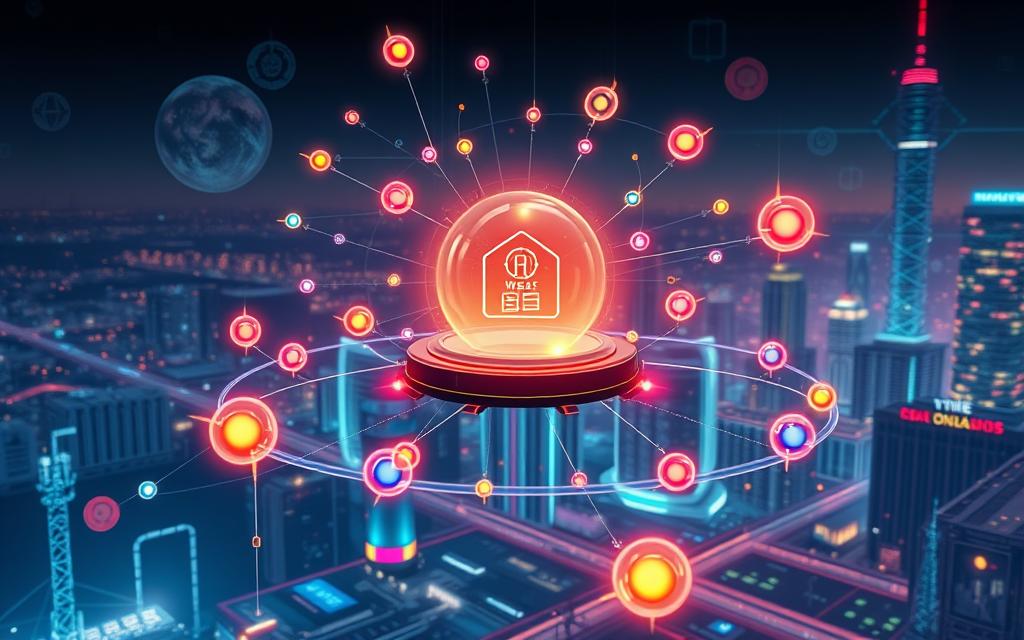In London, The Shed at Dulwich became famous without serving food. This showed the flaws in today’s review systems. It started a big talk about trust online.
Now, in the blockchain world, Token Curated Registries (TCRs) are changing things. They use community-driven curated lists to decide who gets praised. This includes great diners and trustworthy news sites.
At the heart of blockchain curation and reputation, TCRs are making a difference. They make sure everything is open and fair. Unlike old systems, TCRs keep the best content at the top. This is thanks to everyone’s help in choosing what’s best.
Key Takeaways
- Token Curated Registries harness the trust and transparency central to blockchain technology.
- Web3 content curation through TCRs brings power back to the community, making curated lists democratic and reliable.
- Tokens in TCRs create a dual-purpose economy, enriching curators and ensuring authenticity in listings.
- It’s not just about ranking content; TCRs represent a collective validation of quality, with every stakeholder, from consumer to candidate, playing a critical role.
- The technology behind TCRs includes not only blockchain but also the innovative use of smart contracts and dApps, illustrating the intricacies of Web3 content curation.
Exploring the Concept of Token Curated Registries (TCRs)
The world of content curation is changing fast with Token Curated Registries (TCRs) in Web3. This new way uses decentralized curation. It lets token holders help make sure Web3 lists and services are top-notch. TCRs bring community governance and token-based curation together, setting new standards for validating and using information online.
Decentralization and Community Governance in Web3
TCRs are all about decentralized curation. This means giving the power to a network of token holders, not one central person. It makes things more transparent and less biased, unlike old ways of curation.
Community governance in TCRs means token holders vote on what gets listed. This way, only the best stuff makes it to the lists. It’s a fair system where everyone has a say in what’s good.
Creating Trust through Token-based Curation Mechanisms
Token-based curation is key to TCRs. It mixes economic rewards with user participation. Users help decide what’s good by voting with their tokens.
By using tokens, users show they trust their choices. This keeps bad stuff out and makes sure only the best is in. It’s a way to build trust in online information.
TCRs are becoming more popular in different areas. They show a shift towards more open and fair ways of managing online data. As they grow, they’ll be key in how we handle data in Web3.
How Token Curated Registries Empower Web3 Content Curation
In today’s fast-changing digital world, Token Curated Registries (TCRs) are changing Web3 curation. They use blockchain tech to make curation open and fair. This way, content is trusted and true.
TCRs work in a simple yet effective way. People vote on content with tokens. These tokens show how much they care about the content’s quality. This makes sure only the best content gets through.
With tokens, TCRs create a system that checks content well. It stops bad content from getting in. This makes curation fair and trustworthy.
Also, TCRs are open, so no one controls the content. This is key in today’s world where info must be right. TCRs keep curation fair and open to all.
TCRs do more than just tech. They change how we keep content good in the digital world. As they grow, they help make the web better, with more quality content.
Anatomy of a TCR: Tokens and the Registry Interaction
Token Curated Registries (TCRs) use blockchain curation in a unique way. They connect tokens with the registry, creating a decentralized token economy. This connection is key to keeping curated lists trustworthy and useful in the blockchain world.

In a TCR, tokens do more than just act as money. They power the registry’s work. People with tokens vote on what content is good, keeping the registry quality high. This voting system helps the ecosystem stay healthy and strong.
Understanding the Role of Tokens in TCRs
Tokens in TCRs have a big role. They help decide what goes into the registry. This way, the list stays fresh and reflects what the community agrees on. It makes the TCR more valuable and important in the token economy.
The Registry: A Decentralized Approach to Curated Lists
The registry in a TCR is a special ledger. It keeps track of all content that gets approved by the community. Because it’s decentralized, there’s no single person controlling it. This builds trust and makes the lists more reliable.
Decentralized lists build trust and make information more accessible and reliable. As blockchain grows, TCRs become more important. They help manage and verify high-quality content in areas like advertising and digital markets.
Token Curated Registries: The Curation Process and Participants
Token curated registries (TCRs) have a complex system. They involve curators, consumers, and candidates. This system is guided by content moderation and economic incentives. These factors are key to keeping TCRs reliable and useful in the Web3 world.
A Closer Look at Curators, Consumers, and Candidates
Curators in TCRs use their tokens to vote. They help decide the quality of entries in the registry. Their work is vital for the trustworthiness of the lists that consumers rely on.
Candidates must stake tokens to be included in the registry. This shows their commitment. They face the scrutiny of token holders to prove their worth.
Economic Incentives and Stakeholder Dynamics within TCRs
Economic incentives are a big part of TCRs. They motivate everyone to improve the registry’s value. Token holders see their tokens’ value go up as the registry gets better.
This creates a community focused on quality and integrity. The strong structure of TCRs supports this goal.
- Consumers get accurate and clear listings.
- Curators earn more as the registry’s quality improves.
- Candidates gain credibility by being in a well-managed TCR.
The teamwork of all parties makes TCRs work well. They use community input to keep improving. This not only makes the content better but also strengthens the economic model. It keeps everyone involved and engaged.
Frameworks and Technology Fueling TCR Development
The growth of Token Curated Registries (TCRs) relies on advanced technology. This includes smart contracts, decentralized apps (dApps), and the token economy. These tools are key for TCRs to work well. They use blockchain’s security and openness to manage projects.
Smart contracts are vital. They make TCRs run smoothly without human help. These contracts set clear rules on the blockchain. This ensures that how entries are added, challenged, and voted is fair and open.
Decentralized apps act as the face of TCRs. They make it easy for people to help decide what gets added. These apps work with blockchain but feel like regular websites. This makes TCRs easy to use.
The token economy is also important. It deals with how tokens are given out and how people are rewarded. This keeps everyone involved and interested. It makes sure everyone works together well.
Using these technologies makes TCRs real and useful. They help with making decisions in a fair and open way. Here’s how these technologies work together:
| Technology | Function | Impact on TCR |
|---|---|---|
| Smart Contracts | Automate governance and encode rules | Ensures transparency and integrity of the curation process |
| Decentralized Apps (dApps) | User interaction and interface | Enhances accessibility and user engagement |
| Token Economy | Incentive mechanisms | Aligns stakeholder interests and encourages active participation |
In summary, smart contracts, decentralized apps, and the token economy are powerful. They make TCRs strong and useful. These tools help TCRs work well and are ready for more uses in different areas.
Token Curated Registries, TCR, Web3 content curation, curated lists: Real-World Applications
Token Curated Registries (TCRs) are changing how Web3 and decentralized apps handle data and community rules. They use tokens to pick the best content and listings. This makes TCRs like adChain, Kleros T2CR, and DataBroker DAO great examples of how to improve market clarity and data quality.
TCR Use Cases: adChain, Kleros T2CR, and DataBroker DAO
adChain helps make a list of safe advertising domains. It fights fraud and brings more openness to ads. Kleros T2CR makes a fair place for checking crypto tokens. It helps exchanges and investors do their homework and trust crypto more. DataBroker DAO also uses TCRs to keep data honest and reliable in a decentralized data market. It avoids the control of one person over data.
Impact of TCRs on Data Quality and Market Transparency
TCRs make data better and markets clearer. They let the community decide, not just one person. This makes sure the data and listings are accurate and safe for users and buyers to trust. The table below shows how these platforms change market clarity, helping with fair decisions in our digital world.
| Platform | Core Function | Impact on Transparency | User Benefit |
|---|---|---|---|
| adChain | Ad domain curation | Reduces ad fraud | Trust in ad placements |
| Kleros T2CR | Crypto token validation | Enhances asset reliability | Confidence in investments |
| DataBroker DAO | Data marketplace curation | Diminishes data manipulation | Access to verified data |
Conclusion
Token Curated Registries (TCRs) are changing how we make decisions and share information. They are not just ideas but real innovations with big effects. They show how groups can work together well, like when 97% of people agree on important choices.
TCRs mix money rewards with trustworthy information, like ApeLance shows. They have seen over 30 million votes for big projects. This shows how smart use of resources can lead to better Web3 ideas.
TCRs like adChain, Kleros T2CR, and DataBroker DAO are making a difference in many areas. They prove blockchain technology is moving us towards more openness and efficiency. These TCRs are a mix of technology and community leadership, opening a new era in Web3.
